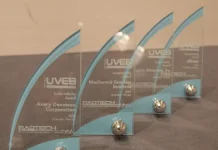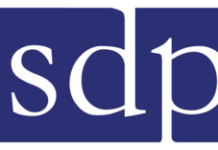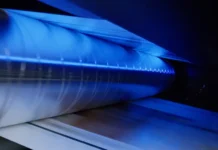RadTech Announces Award Winners
UV+EB Technology
During the RadTech 2016 Conference in Chicago, RadTech International North America, Bethesda, Maryland, awarded Poly6 Technologies, Boston, Massachusetts, with the Accelerator Award and named several Emerging Technologies Award winners for the use of fast, efficient and environmentally responsible ultraviolet (UV) and electron beam (EB) technologies.
The Accelerator Award highlights increasing interest by young people in the development of sustainable new materials and processes. Poly6 Technologies turns citrus rinds into bio-based materials, called Citrene. The start-up is introducing clean and sustainable materials for use in performance applications. Environmental stewardship is one of the most prevailing and urgent global initiatives, and Poly6 is reinforcing the notion that sustainable business is competitive business. Citrene has gained traction in various industries due to its unique combination of performance, process ability and sustainability advantages, offering enhanced performance, natural materials, throughput benefits, and low GHG emissions – all enabled by UV/EB technology.
The 2016 Emerging Technology Award winners included:
PepsiCo – Seeking to lower its carbon foot print, Pepsico looked to EB-Flexo Inks as a replacement for its use of solvent-based materials for snack food packaging. Technological developments around EB ink chemistry and lacquer formulation paired with the right choices of flexographic equipment and substrates are creating stunning advances in print quality and aesthetics. Pepsico reports the use of EB technology reduces VOC emissions as much as 90 percent, with lower energy consumption when compared to conventional thermal drying. EB is considered food friendly, which enables PepsiCo to make attractive, environmentally compliant packaging that is cost neutral when compared to incumbent technologies.
Wavefront – Specializing in state-of-the-art holographic films, Wavefront uses advanced roll-to-roll continuous UV casting lines to manufacture nano/micro structure embossed films on a variety of film substrates. This capability allows WFT to manufacture micro-structures from 200 nanometers up to 150 microns. These unique structures only can be achieved using the latest UV-curing and formulating technologies.
Continuous Composites (CC3D) – Developed a new 3D printing process to print continuous fiber with UV curable resin; they are reportedly the only company in the world 3D printing continuous fiber with thermoset epoxy and the only company to successfully print continuous fiber into free space. CC3D has demonstrated 16x and 8x multi-material nozzles printing at once as a “seamless” path utilizing 6K TOW Carbon Fiber, and 600 TEX Fiberglass. With a focus on functional composites additive manufacturing to scale, CC3D is providing an industrial solution to advanced manufacturing techniques of mid- to large-scale.
HRL Laboratories LLC – By formulating pre-ceramic UV-curable polymers, the team at HRL demonstrated the first-ever additive manufacturing of fully dense, binder-less ceramics, published in the 1/2016 issue of Science. These unique pre-ceramic photopolymers can be integrated into commercially available UV SLA or DLP equipment to produce flaw-free, high-strength ceramics with up to 180°C operating temperatures. Potential applications for this novel technology include turbine engine components, hypersonic vehicle structures, MEMS devices and electronics packaging.
Cleveland Steel Container – Developed the first commercial inline EB and UV process for rigid steel coil substrates in the manufacture of steel pails. CSC applies and cures EB and UV directly to steel coil for 5 gallon pail lids and bottoms. This application is also unique in the use of highly pigmented systems to steel for rigid fabrication. Beyond a dramatic reduction in energy requirements, CSC reports that since “EB coatings are 100 percent solids formulations it means no loss of evaporated solvent from the applied coating. It also means less coating usage and required storage area compared to solvent systems. EB was not only found to be a more efficient technology, it also contributes significantly to a higher level of workplace comfort. Traditional thermal systems are massive, and the company just doesn’t have the additional space required for that kind of set up.
NOVAGARD Solutions – Developed the first industrial UV-LED PSA installation on a coating line. Novagard converted a water-based PSA for its 58″ wide PVC foam line to a UV-LED-curable PSA and now is using it in to produce PVC foam rolls (more commonly known as weather stripping). The system consists of two 62″ wide banks of UV LED curing systems. Conventional UV lamps could not be used as they delivered too much heat to the substrate causing damage. UV-LED was the only viable solution. Going to a UV solution resulted in a superior peel strength allowing Novagard to pursue new market opportunities.
Carbon 3D – Carbons vision is “a future fabricated with light, where traceable, final-quality parts are produced at scale with CLIP technology.” CLIP – Continuous Liquid Interface Production – makes this possible by combining engineeringgrade materials with exceptional resolution and surface finish. By harnessing light and oxygen to produce objects from a pool of resin, CLIP is a photochemical process that eliminates the shortcomings of conventional 3D printing by more rapidly producing objects.
City Of Cleveland and Progressive Field, home of the Cleveland Indians – Noted for the exploration and use of UV-curable materials as a contribution to environmental sustainability in Cleveland; recognizing UV technology solutions to long standing issues for protection against corrosion and to provide superior protection for metals, concrete, stones and other substrates in an efficient and fast curing manner.
For more information, visit www.radtech.org.






